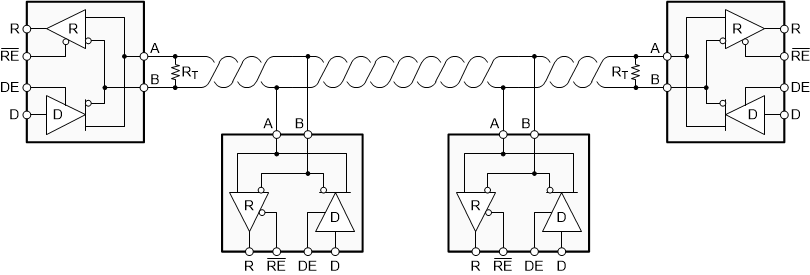SLLSFQ9B May 2024 – October 2024 THVD2410V-EP , THVD2450V-EP , THVD2452V-EP
PRODUCTION DATA
- 1
- 1 Features
- 2 Applications
- 3 Description
- 4 Pin Configuration and Functions
-
5 Specifications
- 5.1 Absolute Maximum Ratings
- 5.2 ESD Ratings
- 5.3 ESD Ratings [IEC]
- 5.4 Recommended Operating Conditions
- 5.5 Thermal Information
- 5.6 Power Dissipation
- 5.7 Electrical Characteristics
- 5.8 Switching Characteristics - 250 kbps
- 5.9 Switching Characteristics - 1 Mbps
- 5.10 Switching Characteristics - 20 Mbps
- 5.11 Switching Characteristics - 50 Mbps
- 5.12 Typical Characteristics
- 6 Parameter Measurement Information
- 7 Detailed Description
- 8 Application and Implementation
- 9 Device and Documentation Support
- 10Revision History
- 11Mechanical, Packaging, and Orderable Information
Package Options
Mechanical Data (Package|Pins)
- DRC|10
Thermal pad, mechanical data (Package|Pins)
- DRC|10
Orderable Information
8.2 Typical Application
An RS-485 bus consists of multiple transceivers connecting in parallel to a bus cable. To eliminate line reflections, each cable end is terminated with a termination resistor, RT, whose value matches the characteristic impedance, Z0, of the cable. This method, known as parallel termination, generally allows for higher data rates over longer cable length.
 Figure 8-1 Typical
RS-485 Network With Half-Duplex Transceivers
Figure 8-1 Typical
RS-485 Network With Half-Duplex Transceivers